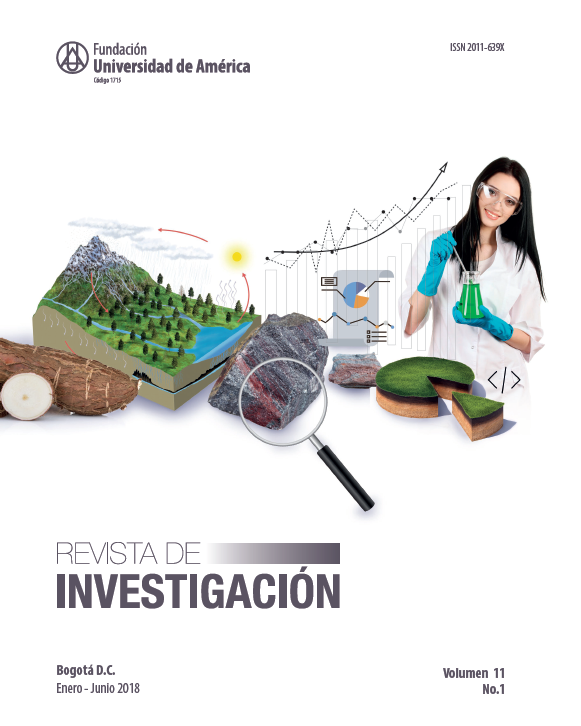Propuesta de ruteo de vehículos con flota heterogénea y ventanas de tiempo (HFVRPTW) aplicada a una comercializadora pyme de la ciudad de Cali
Resumen
Este artículo estudia el problema del ruteo de vehículos con flota heterogénea y ventanas de tiempo (HFVRPTW) para dar solución a un problema real aplicado a una pequeña comercializadora de productos alimenticos de la ciudad de Cali que debe atender un conjunto de clientes con demandas conocidas y que tiene que usar un intervalo de tiempo predefinido por cada cliente. El modelo fue desarrollado en tres fases: caracterización del proceso actual de programación de ruta y distribución, adaptación del modelo matemático y solución del modelo por medio del método heurístico de ahorros, el cual se adapta de manera eficiente al problema. Los resultados evidencian mejoras sustanciales relacionadas con la disminución en el número de rutas de hasta el 40 % para el vehículo tipo NHR, en la distancia recorrida del 50 % para el vehículo Dmax y en los costos totales de transporte para los dos tipos de vehículos.
Citas
Belfiore, P., y Yoshizaki, H. (2013).Heuristic methods for the fleet size and mix vehicle routing problem with time windows and split deliveries. Computers and Industrial Engineering, 64(2), 589-601. https://doi.org/10.1016/j.cie.2012.11.007
Ciancio, C., Laganá, D., y Vocaturo, F. (2018). Branch-price-and-cut for the mixed capacitated general routing problem with time windows. European Journal of Operational Research, 267(1), 187-199. https://doi.org/10.1016/j.ejor.2017.11.039
Domínguez-Martín, B., Rodríguez-Martín, I. y Salazar-González, J. (2018). The driver and vehicle routing problem. Computers and Operations Research, 92, 56-64. https://doi.org/10.1016/j. cor.2017.12.010
El-Sherbeny, N. (2010). Vehicle routing with time windows: an overview of exact ,heuristic and metaheuristic methods. Journal of King Saud University-Science, 22(3), 123-131. https://doi. org/10.1016/j.jksus.2010.03.002
González, G., y González, F. (2006). Metaheurísticas aplicadas al ruteo de vehículos. Un caso de estudio. Parte 1 : Metaheuristics applied to vehicle routing. A case study. Revista Ingeniería e Investigación, 26(3), 149-156.
Golden, B., Assad, A., Levy, L, y Gheysens, F. (1984).The fleet size and mix vehicle routing problem. Computers and Operations Research, 11(1), 49-66 https://doi.org/10.1016/0305- 0548(84)90007-8
Hiermann, G., Puchinger, J., Ropke, S., y Hartl, R. (2015). The electric fleet size and mix vehicle routing problem with time windows and recharging stations. European Journal of Operational Research, 252(3), 995-1018. https://doi.org/10.1016/j.ejor.2016.01.038
Liu, F., y Shen, S. (1999).The fleet size and mix vehicle routing problem with time windows.The Journal of the Operational Research Society, 50(7), 721-732. https://doi.org/10.2307/3010326
Rocha, L., González, E., y Orjuela, J. (2011). Una revisión al estado del arte del problema de ruteo de vehículos: evolución histórica y métodos de solución. Ingeniería, 16(2), 35–55.
Olivera, A. (2004). Heurísticas para problemas de ruteo de vehículos. Recuperado de https://www. fing.edu.uy/inco/pedeciba/bibliote/reptec/TR0408.pdf
Rocha, L., González, El, y Orjuela, A.(2011).Una Revisión al estado del arte del problema de ruteo de vehículos: evolución histórica y métodos de solución. Ingeniería, 16(2), 35-55.
Paraskevopoulos, D., Repoussis, P., Tarantilis, C., Ioannou, G., y Prastacos, G. (2008). Reactive variable neighborhood tabu search for heterogeneous fleet VRP and scheduling. Journal ofHeuristics,14(5), 425-455.
Repoussis, P, y Tarantilis, C. (2010). Solving the fleet size and mix vehicle routing problem with time windows via adaptive memory programming. Transportation Research Part C: Emerging Technologies, 18(5), 695-712. https://doi.org/10.1016/j.trc.2009.08.004
Saaty, R. (1987). The analytic hierarchy process-what its and how its used. Mathematical Mode- lling, 9(3–5), 161–176. https://doi.org/10.1016/0270255 (87)90473-8
Salhi, S., Wassan, N., y Hajarat, M. (2013). The fleet size and mix vehicle routing problem with backhauls: formulation and set partitioning-based heuristics. Transportation Research Part E: Logistics and Transportation Review, 56, 22-35 https://doi.org/10.1016/j.tre.2013.05.005
Sepúlveda, J., Escobar, J., y Adarme-Jaimes, W. (2014).An algorithm for the routing problem with split deliveries and time windows (SDVRPTW) applied on retail SME distribution activi- ties. Dyna, 81(187), 223-231. https://doi.org/10.15446/dyna.v81n187.46104
Solomon, M. (1987). Algorithms for the vehicle routing and scheduling problems with time window constraints. Operations Research, 35(2), 254-265. https://doi.org/10.1287/opre.35.2.254
Toro, O., Escobar, Z., y Granada, E. (2016). Literature review on the vehicle routing problem in the green transportation context. Luna Azul, 42, 362–387. https://doi.org/10.17151/luaz.2016.42.21
Toth, P., y Vigo, D. (eds.). (2014).Vehicle routing problem, methods, and application (2a edición). Philadelphia, EE. UU.: Society for Industrial and Applied Mathematics.












